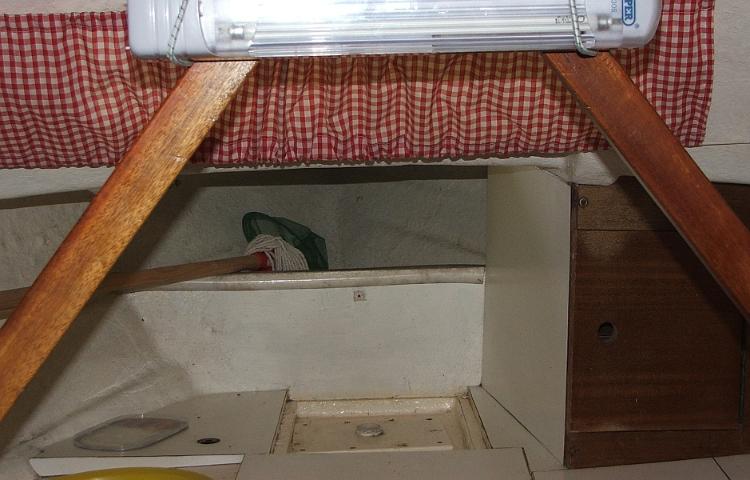Onboard tap
|
Hi,
I've got, I think, an original sink and tap onboard my boat. The tap has a lever which I can pump back and forth but nothing happens. Can anyone tell me if this tap should be pumping water from an onboard tank, which I haven't found, or from the river (which I probably wouldn't want!!). Cheers, Barry |
|
Administrator
|
This post was updated on .
Hi Barry,
Certainly, a tap was never supplied in a "four-berth" boat and as far as I know, Reedcraft, only supplied the galley moulding in their two-berth boats, not a tap. The Reedcraft brochures that I have seen do not show a tap, and it is highly likely they would have done had it been standard! A good number of Reedcraft boats do have a lever-pumped tap on board, but I believe them all to be owner-fitted after delivery. There is no on-board tank fitted as standard to a SeaHawk. I do know of one boat that had a large tank added by a previous owner that the then owner was planning to remove as it was both over large and he found it impossible to keep sterilised sufficiently to hold drinking water. I believe owners the owners who fitted the tap you describe would have linked these, via a short small bore pipe, to half-gallon or gallon bottle stored under the cooker shelf. I recall my parents bought orange squash in half-gallon containers in those days, similar to the four-pint containers you get these days for milk - though the polythene containers are of a much lighter gauge. Such bottles are easy to transport and semi-disposable so there's no need to worry about disinfecting them at the end of a season's use. When my parents bought their SeaHawk new, in 1973, I remember thinking about fitting a tap to it, but decided that it was just as easy to pour water directly from an old orange squash container into a kettle or the sink.
Greg Chapman
GregAfloat - My Boating Biography |
|
This post was updated on .
We have a pumped tap on our sink but I know it was added after Marsh Marigold was built. It connects to a big tank under the floor of the well which we only use for washing these days because of the difficulty of cleaning it out.
Victoria and Alan Sent from Samsung Mobile |
|
In reply to this post by GregSeaHawk
Hi Greg,
Once again, thank you for a full reply. It never occurred to me that the tap would expect a "portable" water tank - I'll have a look under the sink again with torch and mirror (it's an area I find it difficult to get down to!). I couldn't understand why someone would use a tap there rather than a water bag/large bottle - any kudos you got for "running water" on your boat would be instantly negated by having to crouch down into a tiny space and pump the little lever for all it's worth!!! I'll let you know if I find anything interesting... Cheers, waterville |
|
Administrator
|
In reply to this post by Marsh Marigold
Hi Victoria (or Alan)
I remember you showing me over your boat and I've just been looking again at the photos you sent me some time later. You have a very non-standard galley, so I know why you say it was added after Marsh Marigold was built. I really ought to add the pictures to the Cabin Customisations page on the main site. However, I had completely forgotten, if you ever told me, that it was linked to a tank under the cockpit. The photographs below come from the boat I had in mind. You'll see that it has a larger than standard anchor locker in the bows and astern of that is the tank. This reaches the same height as the sink in the galley moulding and stretches the full width of the boat forward of the galley unit. It is largely constructed of melamine faced chipboard but with a lot of GRP matting to reinforce and seal the various panels. the owner told me that its rather small access hatch, together with the rough inner surfaces made it impossible to clean.   In the photographs you can see the hole where the present own had removed the tap. I can't recall but believe that the section of panelling beside the sink was other storage space the previous owner had constructed and not part of the water tank. For me the tank was hugely over-big and one major problem was that it made the forehatch unusable except for ventilation and to pass the mud weight through from the deck (This was a Broads based boat, so mud weight, not anchor). Mudweights are heavy and I always lower/throw and haul mine from inside the boat, standing on the low platform I built at the very front of the cabin. The edges of the hatch then support me and there's no risk of me going overboard along with the mudweight! See the images at: http://www.gregafloat.org.uk/seahawk/3rr2009.html#boatprep as they are more recent than the one at: http://www.seahawk17.org.uk/boatshed/cabins.htm#imagination If I was going to design a SeaHawk water tank, I would place it in the bows - I've seen too many SeaHawks with a large crew of large people to want to add any extra weight to the cockpit! Rather than be a true tank it would simply be a storage bin for a set of collapsible water "bags". That would allow me to sterilise them at home. They would be easy to carry to the boat when full, and would mould themselves to the space I had built for them.
Greg Chapman
GregAfloat - My Boating Biography |
«
Return to Help Desk
|
1 view|%1 views
| Free forum by Nabble | Edit this page |

